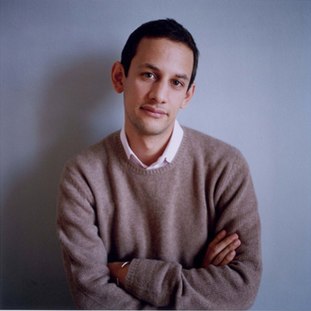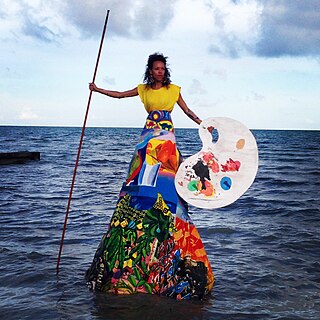Related Research Articles

A curator is a manager or overseer. When working with cultural organizations, a curator is typically a "collections curator" or an "exhibitions curator", and has multifaceted tasks dependent on the particular institution and its mission. In recent years the role of curator has evolved alongside the changing role of museums, and the term "curator" may designate the head of any given division. More recently, new kinds of curators have started to emerge: "community curators", "literary curators", "digital curators" and "biocurators".

Jens Hoffmann Mesén is a writer, editor, educator, and exhibition maker. His work has attempted to expand the definition and context of exhibition making. From 2003 to 2007 Hoffmann was director of exhibitions at the Institute of Contemporary Arts London. He is the former director of the CCA Wattis Institute for Contemporary Art from 2007 to 2016 and deputy director for exhibitions and programs at The Jewish Museum from 2012 to 2017, a role from which he was terminated following an investigation into sexual harassment allegations brought forth by staff members. Hoffmann has held several teaching positions including California College of the Arts, the Nuova Accademia di Belle Arti and Goldsmiths, University of London, as well as others.

Iwona Maria Blazwick OBE is a British art critic and lecturer, and has been Director of the Whitechapel Art Gallery in London since 2001. She discovered Damien Hirst and staged his first solo show at a public London art gallery, Institute of Contemporary Arts in 1992. She supports the careers of young artists.
Ingrid Schaffner is a curator, writer, and educator specializing in contemporary art since the mid-1980s. Schaffner work often coalesces around themes of archiving and collecting, photography, feminism, and alternate modernisms—especially Surrealism. She has curated important exhibitions that have helped studio craft to gain acceptance as fine arts, such as Dirt on Delight: Impulses That Form Clay with Jenelle Porter at the Institute of Contemporary Art, Philadelphia in 2009.
Sue Spaid is an American curator and philosopher, currently based in Belgium.
The Pew Center for Arts & Heritage is a nonprofit grantmaking organization and knowledge-sharing hub for arts and culture in Philadelphia, Pennsylvania, US established in 2005. In 2008, Paula Marincola was named the first executive director. The Center receives funding from The Pew Charitable Trusts and makes project grants in two areas, Performance and Exhibitions & Public Interpretation, as well as awarding grants to individual artists through Pew Fellowships. In 2021, the Center announced the introduction of Re:imagining Recovery grants to assist in COVID-19 recovery.
Shared historical authority is a current trend in museums and historical institutions which aims to open the interpretation of history to the public.
Philip Tinari is an American writer, critic, art curator, and expert in Chinese contemporary art. Based in Beijing since 2001, Tinari is currently director and CEO of the UCCA Center for Contemporary Art (UCCA) in Beijing.

Simone Leigh is an American artist from Chicago who works in New York City in the United States. She works in various media including sculpture, installations, video, performance, and social practice. Leigh has described her work as auto-ethnographic, and her interests include African art and vernacular objects, performance, and feminism. Her work is concerned with the marginalization of women of color and reframes their experience as central to society. Leigh has often said that her work is focused on “Black female subjectivity,” with an interest in complex interplays between various strands of history.
Jane Irish is an American artist, painter, and ceramicist who lives and works in Philadelphia. Working primarily in gouache and egg tempera her paintings are characterized by their perspectives of Rococo interiors and explorations of the legacy of the Vietnam War. Irish infuses sumptuous interiors with memories of colonialism and orientalism, sometimes making raised text within her painting surfaces, which feature war poetry or historical protest text. The text on the surface of her ceramics includes collaborations with prominent art critics like Vincent Katz and Carter Ratcliff and poetry from Vietnam war veterans from a 1972 collection.
Marta Kuzma is a curator, art theorist, and educator. In 2016, she became Dean of the Yale School of Art and is the first woman to serve in that role since the school was founded in 1869.
A community museum is a museum serving as an exhibition and gathering space for specific identity groups or geographic areas.

Claire Tancons is a curator, critic, and historian of art. She was born in Guadeloupe and is currently based in Paris, after spending three years in Berlin and eighteen in the US, of which she lived a decade in New Orleans.
Anne Barlow is a curator and director in the field of international contemporary art, and is currently Director of Tate St Ives, Art Fund Museum of the Year 2018. There she directs and oversees the artistic vision and programme, including temporary exhibitions, collection displays, artist residencies, new commissions, and a learning and research programme. At Tate St Ives, Barlow has curated solo exhibitions of work by artists including Thảo Nguyên Phan (2022), Petrit Halilaj (2021), Haegue Yang (2020), Otobong Nkanga (2019), Huguette Caland (2019), Amie Siegel (2018) and Rana Begum (2018). She was also co-curator of "Naum Gabo: Constructions for Real Life" (2020) and collaborating curator with Castello di Rivoli, Turin for Anna Boghiguian at Tate St Ives (2019).
Amy Sadao is a contemporary art writer, juror, and lecturer who was director of the Institute of Contemporary Art in Philadelphia from September 2012 to September 2019. She oversaw the ICA's fiftieth anniversary as well as exhibitions of Nicole Eisenman, Ruanne Abbas, Jayson Musson, Alex Da Corte, Barbara Kasten, among others. Sadao was executive director of Visual AIDS in New York City prior to her appointment to the ICA directorship. She has been known to engage diverse communities and to center art around the contemporary social and political issues across the globe.

Paula Wilson is an African-American "mixed media" artist creating works examining women's identities through a lens of cultural history. She uses sculpture, collage, painting, installation, and printmaking methods such as silkscreen, lithography, and woodblock. In 2007 Wilson moved from Brooklyn, New York, to Carrizozo, New Mexico, where she currently lives and works with her woodworking partner Mike Lagg.
Kimberly Phillips is a writer, educator and curator in Vancouver, British Columbia, Canada. As of August 2017, Phillips is a Curator at the Contemporary Art Gallery, Vancouver, a non-profit public art gallery. She holds a Ph.D. in Art History, Visual Art & Theory from the University of British Columbia. Phillips has taught at the undergraduate and graduate levels, often teaching curatorial practice and the history of modern and contemporary visual art at Emily Carr University of Art + Design (ECUAD) and the University of British Columbia (UBC). Phillips is Sessional Faculty at ECUAD and is Course Leader for the Low Residence Masters of Applied Art program. Phillips has authored numerous articles and exhibition catalogues on contemporary art and artists. Her writings have appeared in Artforum, Canadian Art Magazine, and Fillip.
Rachel Foullon is an American artist and curator. Foullon has exhibited her works in galleries and museums nationally and internationally in addition to organizing and curating multiple exhibitions across the United States. She is also the Director of Operations at Monkeypaw Productions.
Mia Locks is a contemporary art curator and museum leader.
Henriette Huldisch is a German-born American curator of contemporary art. She is currently the Chief Curator and Director of Curatorial Affairs at the Walker Art Center in Minneapolis, Minnesota. Prior to that, she was the Director of Exhibitions at the MIT List Visual Arts Center in Boston, Massachusetts.
References
- ↑ "Center Executive Director Paula Marincola Featured in Philadelphia Magazine's "Power Issue" - News - The Pew Center for Arts & Heritage". www.pcah.us. 2017-04-11. Retrieved 2017-04-11.
- ↑ "Philly Rebooted: The Biggest Ideas of 2016 — and Beyond". Philadelphia Magazine. 2016-10-15. Retrieved 2017-04-11.
- ↑ "Center Executive Director Paula Marincola Receives Honorary Degree from Drexel". The Pew Center for Arts & Heritage. 2016-06-12. Retrieved 2018-10-25.
- ↑ "artforum.com / search". artforum.com. Retrieved 2017-04-11.
- ↑ "PAULA MARINCOLA". Drexel University. Retrieved 2018-10-25.
- ↑ Rice, Robin. "A New Pew Initiative". mycitypaper.com. Retrieved 2017-04-11.
- ↑ "About - The Pew Center for Arts & Heritage". www.pcah.us. 2017-04-11. Retrieved 2017-04-11.
- ↑ "Art for All". magazine.pewtrusts.org. Retrieved 2017-04-11.
- ↑ "Issues Archive - Philadelphia Magazine". Philadelphia Magazine. Retrieved 2017-04-11.
- ↑ "Site Read: Seven Curators on Their Landmark Exhibitions". Mousse Publishing. Retrieved 2020-02-14.
- ↑ "In Terms of Performance". www.intermsofperformance.site. Retrieved 2017-04-11.
- ↑ "Staff | Arts Research Center". arts.berkeley.edu. Retrieved 2017-04-11.
- ↑ Marincola, Paula; Nesbett, Peter, eds. (2014-01-31). Pigeons on the Grass Alas: Contemporary Curators Talk about the Field. The Pew Center for Arts & Heritage, Philadelphia. ISBN 9780988710900.
- ↑ "Curating Now: Imaginative Practice/Public Responsibility" (PDF). pcah.us.
- ↑ Halbreich, Kathy; Hickey, Dave; Godfrey, Marian A. (2002-01-15). Marincola, Paula; Storr, Robert (eds.). Curating Now: Imaginative Practice/Public Responsibility. Philadelphia, Pa.: Philadelphia Exhibitions Initiative. ISBN 9780970834607.
- ↑ Marincola, Paula, ed. (2007-02-16). What Makes a Great Exhibition?. Reaktion Books. ISBN 9780970834614.
- ↑ Adamson, Glenn; Antonelli, Paola; Basualdo, Carlos; Blazwick, Iwona; Cooke, Lynne; Golden, Thelma; Jacob, Mary Jane; Kipnis, Jeffrey (2014-12-08). Marincola, Paula (ed.). What Makes a Great Exhibition?. Reaktion Books.